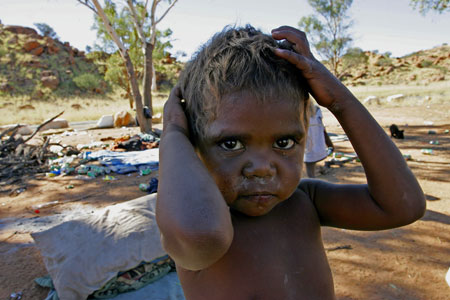 Alice in land of shame Alice in land of shame
Aborigines in Australia still off the map, 40 years after landmark vote
By Neil Sands
ALICE SPRINGS, Australia, (AFP) - Huddled around a campfire in a community deemed unworthy of inclusion on Australia's official maps, Aboriginal elder Dick Brown reflects on a vote that ended the practice of counting his people among Australia's flora and fauna. "We thought that it would change for the better," Brown says without rancour when asked about the 40th anniversary of a landmark vote that recognised Aborigines as full Australian citizens for the first time.
He is speaking from one of the impoverished ghettos surrounding Alice Springs where most of the town's Aboriginal population lives.
The guide books handed to tourists flocking to the "red centre" and maps around the town do not show the sites where indigenous communities are settled, marking them as either blank or parkland.
As the country marks the referendum today, indigenous activists say the omission is a telling indication of the problems they still face.
"I think they'd like us to disappear as well, then we wouldn't be a problem for them," said William Tilmouth, head of the Tangentyere Council, which manages the Aboriginal communities known as "town camps".
Substance abuse and violence
There are huge social problems among the 3,000 Aborigines in the camps here, with high rates of alcoholism and domestic violence and until recently an epidemic of petrol sniffing among youths.
There are 18 officially recognised camps, some of them just 1.5 kilometres (0.9 miles) from the centre of Alice Springs, with another two unofficial sites made up of tin sheds known as humpies.
At one camp here, a group of inhabitants sat in a circle mourning a woman stabbed to death in a domestic dispute the previous week. At another, a woman had recently died when she was run over after falling asleep on the road.
Tilmouth says that up to 30 people are sometimes crammed into a single house when visitors from outback communities come into the camps, often staying for three months at a time.
The road to a camp called Little Sisters, just south of Alice, has no sign indicating there is a settlement nearby, although authorities have erected a "landfill" notice pointing to the town dump which lies down the same track.
Car wrecks and beer cans litter the ground at Hoppy's camp, on the banks of the dry Charles River, as residents gather around an open fire to ward off the chill of the approaching desert night.
Camp elder Brown says conditions have improved since a number of petrol sniffers were taken away for rehabilitation. "It was worse with the sniffers," he said. "When they're sniffing they can't hear you because their brain is finished," he added, tapping his index finger to the side of his head in the universal "crazy" gesture. Brown, 58, is partially paralysed down one side after a stroke but prefers to stay in the camp rather than hospital so he can be with his extended family.
"They're a big mob, they make me mad sometime," he says, pointing to children playing with dogs in the ochre dirt around the campfire.
"People's conscience got pricked"
Tilmouth said black and white communities in Alice Springs existed in mutually distrustful "separate worlds" that seldom crossed paths, even though Aboriginal art is a mainstay of the town's white-dominated tourism industry.
It is a stark contrast to the optimism present in 1967 when 90.77 percent of Australians voted to erase clauses in the constitution that discriminated against Aborigines, the country's largest referendum majority ever.
The referendum gave full citizenship to Aborigines and included them in the national census for the first time, ending the previous practice of counting them as part of the country's native wildlife along with kangaroos and koalas.
The vote followed a civil rights campaign inspired by the work of black US leaders such as Martin Luther King, including "freedom rides" on buses to highlight the problems in remote Aboriginal communities.
"People had a conscience, people had treated indigenous people pretty badly and I think their conscience got pricked and they wanted to go about doing things differently," Tilmouth told AFP.
Aboriginal health "100 years behind"
However, official statistics show little improvement in the plight of Aborigines, who first settled in Australia some 50,000 years ago and lived a nomadic existence until European colonists arrived in the late 18th century.
Aborigines number 470,000, or about 2.3 percent of Australia's 20 million people, yet they form 25 percent of the prison population.
Indigenous infant mortality and coronary heart disease rates are three times those of non-indigenous Australians.
The Australian Medical Association (AMA) says Aborigines are dying more than 17 years earlier than the rest of the population because of "institutionalised racism" in the health system.
The gap in life expectancy was a national disgrace and the government needed to show a greater commitment to Aboriginal health, the country's top body for doctors says. |

 Alice in land of shame
Alice in land of shame